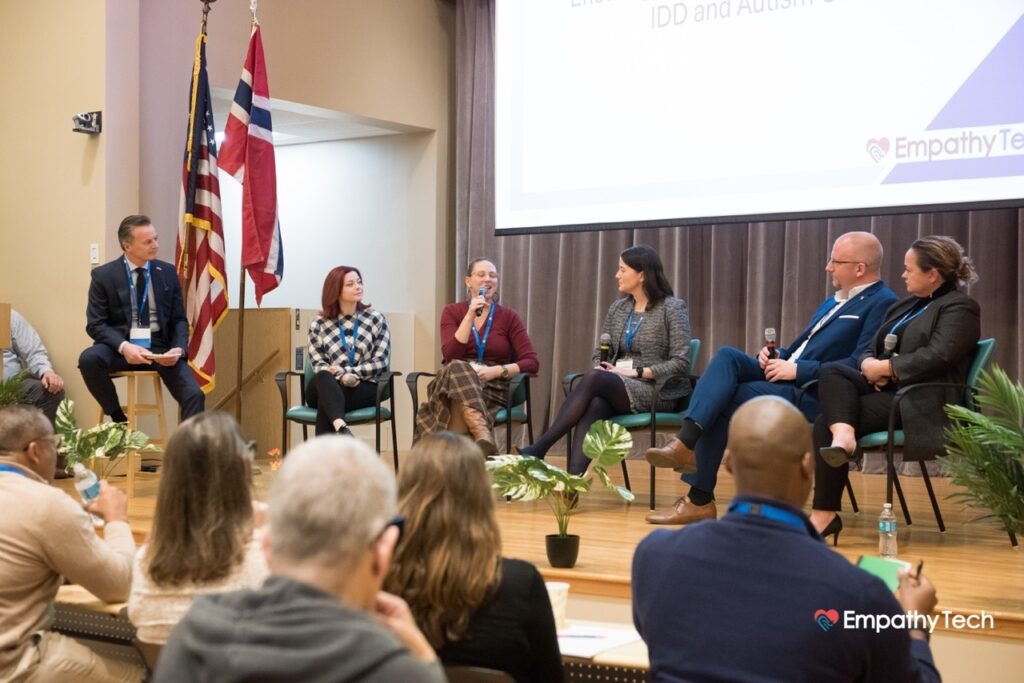Innovation in IDD and Autism Care

Innovation in IDD and Autism Care: Perspectives from Clinicians, Researchers, and Entrepreneurs
By Jonathan Zhu, BSN, RN
For many of the panelists in the inaugural EmpathyTech Philadelphia conference, innovation in the care of people with autism or intellectual and developmental disabilities (IDD) isn’t just a professional pursuit; it’s personal. Drawing inspiration and insight from family members and patients, the panelists shared their perspectives on the potential of technology to make a real difference in people’s lives, and the research and implementation science needed to realize that potential.
Moderated by Geir Landsgård, the panel featured clinicians, researchers, entrepreneurs, and family members, with some panelists wearing multiple hats. They included:
- Elisabeth Sheridan, PhD, Director of the Clinical Core at the J. Drexel Autism Institute and an Associate Professor at Drexel University. Her research interests include the dissemination and implementation of best practices for people with autism in community settings.
- Heather Nuske, PhD, Research Assistant Professor of Psychiatry in the Penn Center for Mental Health, and Director of the Digital Mental Health @ Penn working group. She has a younger brother with autism.
- Sara Glofcheskie, founder and CEO of Beme.ai, a health technology company focused on improving care and research for individuals with autism and IDD. Her work is informed by her personal experiences of caring for a child with autism.
- Kathleen Ramsey, PhD, clinical psychologist in the Center for Autism Research at the Children’s Hospital of Her research focuses on early autism screening in primary care.
- Marius Mathisen, co-founder and CEO of Pletly, an international company that develops assistive technology to enhance communication and collaborative care for individuals with intellectual disabilities and their caregivers. He is the stepfather to a young adult with IDD.
Cultivating Connection in IDD and Autism Care Innovation
The panel began by discussing the state of innovation in autism and IDD care. In the past few decades, technology has advanced rapidly while health care has lagged in adopting new approaches. As entrepreneurs now rush to fill this gap, a wave of new technological solutions has flooded the market. Mathisen stated that “although the markets may be saturated with a lot of well-intended products, most of them fail to completely address the problem.” Empathy-driven technology, the panelists noted, can only emerge through collaboration with families and stakeholder engagement at all phases of innovation, including design, testing, and implementation.
For entrepreneurs seeking to get involved in autism care, building relationships with patients, clinicians, and researchers is a crucial step. To enhance trust with families and researchers, Sheridan challenged entrepreneurs to reflect on their own motives: “Are you doing this for the right reasons?” Glofcheskie pointed out that it’s important to “show researchers the value of your product” by clearly explaining its connection to the real world and providing an argument for why someone would want to enroll their child in a study. Nuske described a list of helpful methods to approach these stakeholders, including “attending events like EmpathyTech, conferences, and reaching out by email.”
Facilitating Empathy and Impact: Listening to Stakeholders
Panelists emphasized that in the process of developing innovative solutions, researchers and entrepreneurs should incorporate the perspectives of various stakeholders.
For example, navigating too many technological options can become overwhelming for caregivers and family members. Several panelists described “app fatigue,” where the sheer volume of technologies can often exacerbate caregiver stress and mental health symptoms. One way to assess feasibility and accessibility, Sheridan noted, is to conduct focus groups where participants identify facilitators and barriers to using the technology and to participating in studies (such as access to transportation). Capturing these insights can help to increase participant buy-in and inform future approaches.
In conducting these studies, researchers should take into account participants’ busy schedules and responsibilities. Nuske proposed that data collection be simplified, and that participants be paid for completing surveys. Sheridan echoed these sentiments, reminding researchers not to add more tasks than necessary to caregivers’ already very busy days.
The experiences of clinical professionals need to be considered as well when incorporating new technologies. Glofcheskie emphasized that “tools have to flow into the daily flow of life for professionals and families.” In creating an AI-powered app specifically for people with autism, Glofcheskie and colleagues worked with nearly 300 participants in an iterative development process, where they continuously improved on their platform and collected data during each phase of testing. Ramsey noted that she and colleagues have conducted focus groups with caregivers and primary care providers as they develop an early autism screening technique in primary care that utilizes computer vision tools.
Translating Research to Practice
Panelists gave examples of how research can translate into practical solutions in autism and IDD care.
As part of a study on the connection between autism and epilepsy, Beme.ai used its platform to obtain data on pain and headaches from children with limited speaking capabilities. Working with a device manufacturer, the researchers used a module that collects biometric data passively. Glofcheskie noted, “If we can capture this data and it’s reliable, so it’s just something that the individual is wearing and we can accurately know when are they in pain, when are they anxious, when are they happy, we can connect that to everything else that’s going on in their lives…it’s also a path for commercialization for this device company to use it in a practical setting, in the real world, where it makes a difference.”
Nuske described a collaboration with Pletly, in which they co-developed and tested a mobile application and web-based platform to streamline communication between professional caregivers and families of adults with autism in residential care. This project helped inform features of Pletly’s platform that connect caregivers and professionals through not only data, but also “soft communication” about day-to-day occurrences. Study participants provided feedback on the feasibility, acceptability, and usability of the application. Nuske read this comment from a professional caregiver:
“I feel most of the time when we reach out to parents and guardians it’s something bad happened or we notify them about an incident. I think this platform encourages more positive communication…I do think it’s valuable to let parents hear more positive things about what’s going on during their kid’s day.”
The Future of Innovation in IDD and Autism Care
The panelists identified several key areas to address to promote research in IDD and autism care and translate those findings into clinical and technological approaches that have a real impact, including:
- Bolstering financial assistance for entrepreneurs, especially during the earlier stages of fundraising. Glofcheskie described the inefficiency of the current paradigm where investors are more prone to think “when you’re successful we’ll fund ” She called for allocating more government resources and attracting venture capital to support early- stage innovation.
- Improving channels of communication between scientists and families or Sheridan and Ramsey pointed out that academic articles are often locked behind paywalls, and written in a manner that is indigestible for the general public.
- Engaging stakeholders earlier and more systematically. Ramsey spoke about incorporating more community-based participatory research (CBPR) designs, participants play an active role in the study design and approach from the
Despite the urgency of improving IDD and autism care, it is also necessary to proceed with caution when implementing new technologies. Mathisen mentioned that, because you “can’t break things and jeopardize participants’ health outcomes” in the health care space, it may be necessary to establish longer development periods. Ultimately, innovation in IDD and autism care should be built on a foundation of empathy and a desire to produce tangible change.
Sheridan concluded, “Our job as parents, as clinicians, is to advocate: does this actually improve quality of life and help people?”


